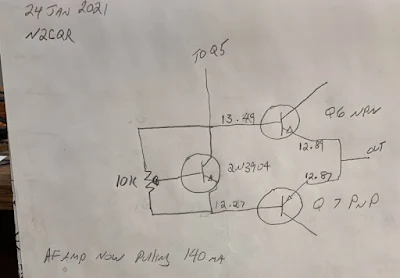Soldersmoke Podcast #228 is available:
Of course, no travel.
But vaccines are here so maybe soon we can leave our shacks.
In the meantime:
I’ve been playing chess against AI bots on chess.com.
Netflix recommendation:
The Bureau. From France. A review from NPR:
https://www.npr.org/2020/06/22/881642358/addictively-suspenseful-thriller-series-the-bureau-will-keep-you-on-edge
A reading from "Conquering the Electron." Germanium vs. Silicon.
Bill’s Bench:
The KLH Model Twenty-one II.
Acoustical Suspension. First receiver
WITH A PILLOW! Bad speaker? Blown AF amp
finals. Hot heat sink. VBE Multiplier. Desitin.
Tony Fishpool’s recommended LM386 boards. 10 for 11 bucks. Nice. They
work. Pictured in the Amazon ad at the
upper right of the SolderSmoke blog page.
Putting a digital display on the Lafayette HA-600A
Test gear trouble. My
Radio Shack multimeter getting flaky. I
many need something better. Auto
ranging? My beloved Maplin AF generator died – will have to fix. I need that
thing. Probably a bad chip. Good thing they are socketed.
I almost forgot about SKN!
But I remembered and I made one contact with the HT-37 and Drake 2-B.
Pete’s Bench:
Presentation to RSGB on Homebrew.
TenTek Troubleshoot.
Swan 240? Looking
nice.
SDR adventures.
MAILBAG
Bill N8ET sent me some really nice Showa 9 MHz 8 pole
crystal filters.
Kevin AA7YQ Smoke jumper!
Building a hybrid SDR.HDR rig.
Launched blog. FB
Nick M0NTV working on similar HDR/SDR project. Great video.
Grayson KJ7UM Hollow State Design – Launched a new
blog. Very FB!
Thomas K4SWL of SWL Post blog. Kearsarge Mountain Transmission system. And recent events.
Peter VK2EMU Poetry.
CW poetry.
Pete WB9FLW looking at DSB rigs…
Drew N7DA Feels not
like a real ham because he hasn’t built a quad from bamboo. Which type of
landscape bamboo is best for antennas?
Ryan Flowers of MiscDotGeek.Com blog is also watching the
Tally Ho YouTube videos of Leo Sampson. Wants to put a WSPR beacon on the Tally
Ho.
Joe KF5OWY Working
with diode ring mixers, trying to see the mixer action on his ‘scope. 1 and -1!
Jim AB9CN sent a cool idea about how to do a 20/17 Moxon.
Roy GM4VKI – I thanked him for his article in SPRAT about
putting a 2n3904 on the output of an NE602 10P mod. Brilliant.
Roger Hayward Told him that I really liked his Dad’s recent
web site updates.
Farhan – Jokingly cursed me for showing him the Oscillodyne
regen of Hugo Gernsback and Jean Shepherd. “Now I will have to build this!”


































.webp)










